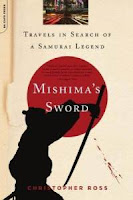 Author: Yukio Mishima
Author: Yukio Mishima
Translator: Alfred H. Marks
U.S. publisher: Alfred A. Knopf
ISBN: 9780375705168
Released: February 1999
Original release: 1951/1953
In Japan, Yukio Mishima’s novel Forbidden Colors was released in two parts. The first eighteen chapters were compiled in 1951 while the collection with the final fourteen chapters was published in 1953. The English translation of Forbidden Colors by Alfred H. Marks was first published by Alfred A. Knopf in 1968. Like Mishima’s earlier novel Confessions of a Mask, Forbidden Colors deals with prominent homosexual themes, although the two works approach the material in vastly different ways. Also like Confessions of a Mask, and many of Mishima’s other works, Forbidden Colors contains some autobiographical elements. In addition to being my introduction to Japanese literature, Mishima and his works fascinate me. I’ve been slowly making my way through all of his material available in English, but I was particularly interested in reading Forbidden Colors.
After being betrayed time and again the aging author Shunsuke Hinoki has developed an intense hatred of women. Seeking revenge, he enters into a peculiar arrangement with a beautiful young man by the name of Yuichi Minami. Yuichi has come to realize that he loves men and is tormented by what that means living in a society which doesn’t accept homosexuality. Shunsuke is willing to assist Yuichi in hiding his secret by helping to arrange his marriage and to develop a reputation as a philanderer. In exchange, Yuichi promises Shunsuke to make the women he seduces miserable. They may fall in love with him, but he will never love them in return. The agreement is advantageous for both men. Yuichi will have a perfect cover allowing him the freedom to explore his sexuality—no one would suspect a married man and a womanizer to have male lovers—and Shunsuke will have the revenge he so greatly desires.
Shunsuke is an unapologetic misogynist. His anti-women rhetoric can be difficult to take, but without it the plot of Forbidden Colors would never go anywhere. It is necessary and important as the story’s catalyst. Mishima has very deliberately created a distasteful character who at the same time is enthralling in his extremes. Yuichi, despite being loved by all, isn’t a particularly pleasant person, either. However, I did find his portrayal to be much more sympathetic. He’s vain and self-centered, but he also has an air of naivety and innocence about him. Both men and women fall victim to his charms but Yuichi himself is often manipulated as well. Forbidden Colors is an absorbing tale as Yuichi struggles to keep his two lives separate, sinking deeper into Japan’s underground gay community while trying to keep up appearances in his public life. It’s an outlandish battle of the sexes that is hard to look away from and no one comes out unscathed.
Forbidden Colors explores and deals with a number of dualities: homosexuality and heterosexuality, love and hatred, youth and old age, beauty and ugliness, truth and deceit, cruelty and kindness, morality and immorality, and so on. Mishima plays the dichotomies off one another, but also reveals how closely intertwined they can be. The complexities of the characters’ relationships show that opposites are rarely just that and how at times in the end they aren’t really all that different. Yuichi, for example, comes to genuinely care for his wife but in his twisted way of thinking expresses that love through cruelty. There is a certain logic to his decision and his concern is real, though someone else might not reach the same conclusion. At it’s heart Forbidden Colors is a fairly dark story with erotic underpinnings and characters who, though often unlikeable, are captivating. I found the novel to be incredibly engrossing.




